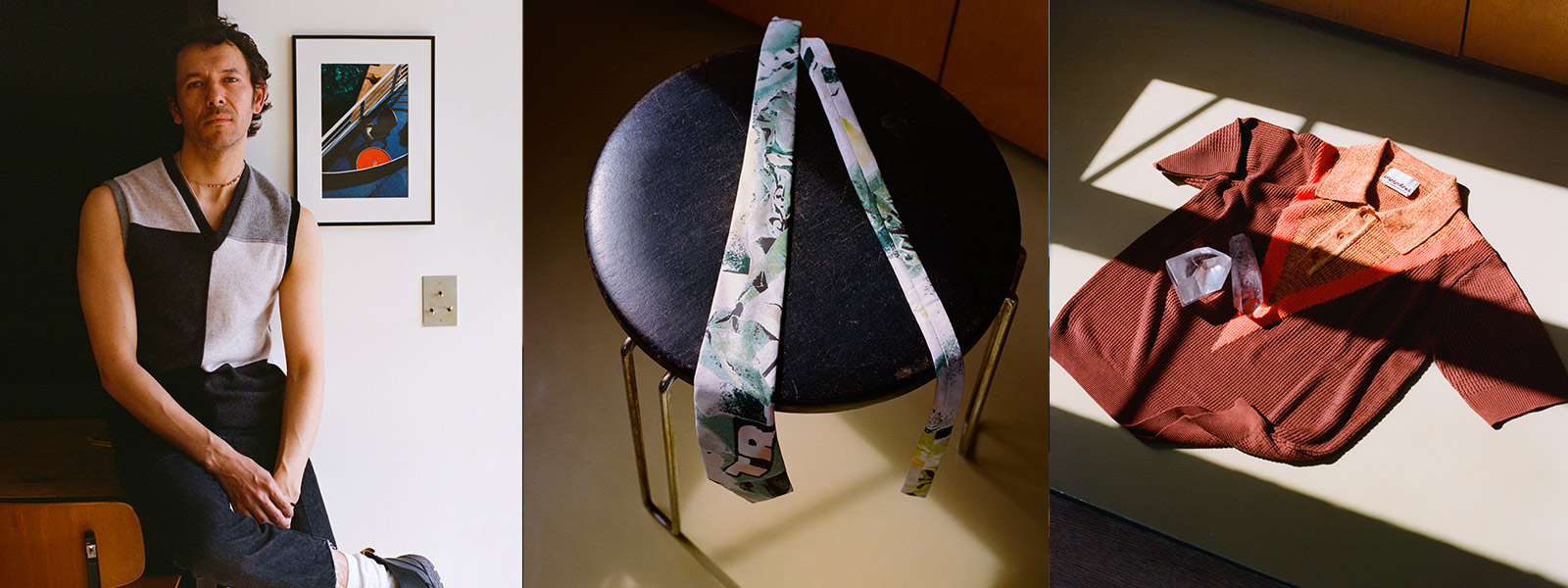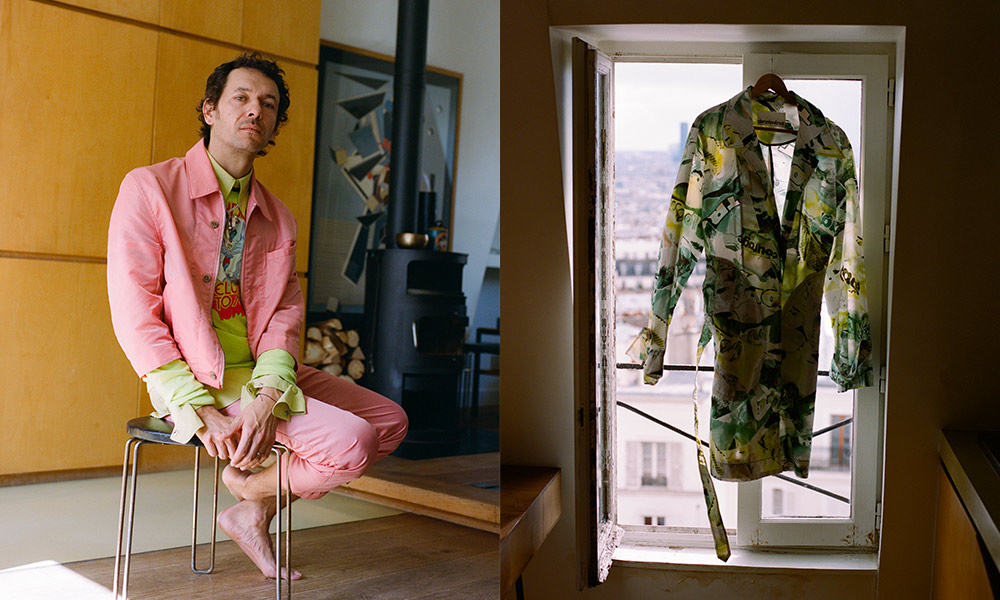
SUSTAINABLE SYMPOSIUM
denzilpatrick
by Francesco Dossi
denzilpatrick is a London-based menswear brand that stands out for its genuine intentions in terms of sustainability, evident know-how in all stages of the pieces’ production, and original plus effective communication choices. Which is not surprising at all, considering Daniel Gayle’s long and remarkable career in fashion. The founder designer of denzilpatrick has worked in the studios of Jonathan Saunders, Philip Lim, and Kenzo, as well as his six years working for Victoria Beckham. The collections that’ve been released since the brand’s founding reflect Daniel’s deep connection to the southeast area of London and his personal approach to the themes that inspired its creation. They are often born from his own personal experiences and family history, from which the name ‘denzilpatrick’ derives from (composed of the first names of Gayle’s grandparents, who were immigrants from Ireland and Jamaica).
Are there any challenges you didn’t expect to face when you were working for other labels? If yes, what are they?
All the opportunities I’ve taken up until now have led me to this point, this very clear picture of what I want to represent and stand for, so I never really think of challenges in those terms. But of course, there were times over the years when I was faced with difficult decisions or, executing projects in ways that were not really aligned with my principles. But these were all learning experiences for me, and those companies also did a lot of great work, with great intention.
In a past interview, you spoke about your creative process and more precisely about ‘building some kinds of fantasy theoretical scenarios that don’t necessarily have to be about you, but which actually come through your essence’. Is that still working for you?
Yes! This is very much the foundation of every collection still. Each season begins from a memory or, story or, scenario from my history. We then dissect that, try to understand why the memory stuck around and what that meant to me. And from there we build! Adding to the board the characters involved, the setting of the memory, location, time, season, and day of the week! With this base we start to imagine, fantasize if you will, how these characters begin to interact, where are they going? Who with? Why? And of course, what are they wearing? What are their sartorial codes? Whilst it’s imagined it’s very much my imagination, so impossible to separate from myself.
Your latest collection, ‘All Dressed up and Somewhere to Go’, is imbued with emotional and personal references coming from your family, an essential trait for the brand since its birth. Would you say the concept of sustainability is linked to your past and to your familial dynamics in some ways? Or is it something you grew attached to over the years?
I wouldn’t say we were specifically a sustainable family, but I grew in a very resourceful environment where excessive consumption and waste was not only frowned upon but just not an option! We were six people living in a two-bedroom apartment – we were very space efficient! My dad is a carpenter and so our furniture was custom built into every inch of free space available. And no materials were ever wasted, all small offcuts of wood were repurposed for another use. And mum was always patching over knees and elbows and turning trousers into shorts and sweaters in tanks to give our clothes another life! This stuck with me, this sense of resourcefulness has always been with me, and so became a principle of the way we build the collections at denzilpatrick: there’s a real value in good materials and high-quality making, It’s my job to cleverly design and interpret, to present an exciting context for materials to our community.

After working in fashion for so many years, what would you say the most unsustainable aspect of the industry is, and what types of mechanisms could easily be left out for the industry to become more sustainable?
For me, one of the most unsustainable aspects is really waste. Initially, in the development process – I found the overordering on materials quite unnecessary. I think there’s more efficient ways of doing this today, using photoshop and other digital manipulations help us to make more certain decisions before we launch our fabrics so we can be more certain in the choices. And the wastage in production for me is an issue. Innovation has already started finding ways of using up leftovers of fabrics in the dead stocks business. But it’s the cutting waste that also needs to be address. Manufacturers will always do their best to cut the garments in the most efficient way, but ultimately there’s still huge volumes of clean textiles wasted going to landfill: this waste can be repurposed in many ways – the most circular is shredding and re-spinning into other textiles. There are a few companies that now offer this service but the connection to the manufacturing industry is still not complete – this is really where we need to see improvement. However, it can’t just be on the factory: all elements of the supply chain need to team up to make this cost and time efficient for all.
On denzilpatrick’s website, I read among your values that ‘it takes many hands, in many different locations, with many different stories to bring to life these pieces’. That’s amazing and a truth for many other realities. Therefore, it made me wonder: how come that, most of the time, companies tend to leave all these wonderful stories ‘behind the scenes’, so to speak? What are your thoughts on that?
For denzilpatrick and me personally it’s vital to credit the partners, collaborators, supporters, makers, and all those that bring the story to life. It’s just not realistic to think I do this on my own. Of course, the responsibility is mine and the decisions taken, but so many fantastic people bring their expertise and skills to the table: that’s the best part for me, really discovering and platforming something or someone that was maybe not as well known. I think more and more people today are sharing their makers and their teams. There is a movement towards more honest communication, certainly amongst my peers, at least. For anyone else, I imagine they want to keep a sense of mystery, although I don’t know why!
What’s the greatest benefit to you of having a meaningful connection with sourcing and manufacturing?
The greatest benefit is the relationships I get to make with these people. In many ways it like an alternative family. We have these intense periods of time spent together as we collaborate and bring ideas to life; either when I spend time at the factories developing samples, eating with them and their families, or when we are doing hand-embroiderer camps at our studio in the final days of the collection preparation, as we add the finishing touch.

In the wonderful ‘transparency categories’ section of your website, you mention the interesting denzilpatrick approach to screen-printing, particularly related to the sports elements of the collection, which is a category that often struggles to meet sustainability goals. I feel like people don’t often talk about it. Could you elaborate on this category issue?
So great to hear that you’ve seen that on the site! We wanted to be as open and clear as possible in all that we are doing. We’re still not perfect but we strive for it! Screen printing allows us to control the colours, artwork, fabrics we need to work with, and quantities; we can do very small orders or scale up when needed. And I find it a very qualitative product. We do digitally print in Italy onto organic cottons and recycled polyester – it’s a little more water intensive but it allows us (at our relatively small scale, industrially speaking) to bring all-over print and vivid colours without compromise.
Again, there’s a lot of innovation coming through today in the sportswear field; the big ones like Nike and Adidas have the infrastructure and budgets to explore here! I’d love to partner with them and bring a little romance and storytelling to that world, something with a little more charm!
Clothes have the power to make you feel certain ways, especially when you know the design behind them is meaningful and thoughtful. What would you like for people to feel when they wear denzilpatrick?
Great question! I’d like people to feel their best selves; empowered, free of guilt, happy they invested in something long lasting and designed with the best of intentions from a place of love.

Credits: Pictures by Antonino Cafiero, Interview by Francesco Dossi